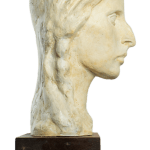Ferdinand Hodler (Bern, 1853-Geneva, 1918)
Bust of Valentine Godé-Darel, c. 1914
Paster
33.2 x 19.1 x 20.1 cm
Original base: 9.5 x 21 x 15 cm
Original base: 9.5 x 21 x 15 cm
Signed lower right F. Hodler
PRICE UPON REQUEST
Further images
Ferdinand Hodler (1853-1918) is one of Switzerland's most significant artists. He is recognized as the founder of Swiss modernity as well as one of the most important artists for European...
Ferdinand Hodler (1853-1918) is one of Switzerland's most significant artists. He is recognized as the founder of Swiss modernity as well as one of the most important artists for European modernity. His artistic journey began in Bern, honing his skills in painting. He later studied in Geneva, which became a significant base for his artistic development. His work is characterized by a bold use of vibrant colors, a strong expressive brushstroke, and rhythmic compositions, often exploring themes of nature, human style, Ferdinand Hodler succedded in gaining international recognition for his art.
From 1914 to 1915, during the illness of his companion Valentine Godé-Darel (1873-1915), Ferdinand Hodler created a poignant series of oil paintings capturing her phyiscal decline, and most of these paintings are now preserved in museums in Switzerland. In addition, at the beginning of 1914, Ferdinand Hodler created three plaster sculptures representing the bust of his companion. Like the paintings, these sculptures reflect Ferdinand Hodler's deep emotion connection with his companion, but they also reveal the lesser-known side of Ferdinand Hodler as a sculptor. Despite having won a first prize in sculpture at the age of twenty, the Swiss artist's sculptural production is extremely sparse and rare. At the beginning of the 20th century, it was believed that only one sculpture by the Swiss artist was known: an unsigned plaster Bust of Valentine Godé-Darel (now in the collection of the Musée Jenisch in Vevey). Subsequently, an unsigned plaster medal project representing William Tell (now at the Museum of Art and History in Geneva) was discovered, along with two other plaster busts of Valentine. One, also unsigned, is in private hands, while the other, recently rediscovered and which is signed, is the bust we present here.
The present plaster is the third and last Bust of Valentine Godé-Darel known. It is the only one signed by Ferdinand Hodler. Our bust is mentioned in the exhibition catalogue of the Musée Jenish, where it was exhibited alongside the three other busts, even though it is not included int he list of artworks presented at the exhibition, as its rediscovery happened too shorty before the publishing of the catalogue. Ferdinand Hodler's expert Niklaus Manuel Güdel suggests that the Swiss artist might have created the present bust after the first two, and signed it to facilitate the commercialization of the bronzes, cast after the artist's death at the request of the dealer Max Moos (1880-1976), from whom our plaster comes. The present plaster is the only signed Bust of Valentine Godé-Darel sculpted by Ferdinand Hodler and constitutes a magnificent witness to Ferdinand Hodler's art as a sculptor, as well as to the intimate relationship between the artist and his beloved Valentine Godé-Darel, who passed away on January 25, 1915.
From 1914 to 1915, during the illness of his companion Valentine Godé-Darel (1873-1915), Ferdinand Hodler created a poignant series of oil paintings capturing her phyiscal decline, and most of these paintings are now preserved in museums in Switzerland. In addition, at the beginning of 1914, Ferdinand Hodler created three plaster sculptures representing the bust of his companion. Like the paintings, these sculptures reflect Ferdinand Hodler's deep emotion connection with his companion, but they also reveal the lesser-known side of Ferdinand Hodler as a sculptor. Despite having won a first prize in sculpture at the age of twenty, the Swiss artist's sculptural production is extremely sparse and rare. At the beginning of the 20th century, it was believed that only one sculpture by the Swiss artist was known: an unsigned plaster Bust of Valentine Godé-Darel (now in the collection of the Musée Jenisch in Vevey). Subsequently, an unsigned plaster medal project representing William Tell (now at the Museum of Art and History in Geneva) was discovered, along with two other plaster busts of Valentine. One, also unsigned, is in private hands, while the other, recently rediscovered and which is signed, is the bust we present here.
The present plaster is the third and last Bust of Valentine Godé-Darel known. It is the only one signed by Ferdinand Hodler. Our bust is mentioned in the exhibition catalogue of the Musée Jenish, where it was exhibited alongside the three other busts, even though it is not included int he list of artworks presented at the exhibition, as its rediscovery happened too shorty before the publishing of the catalogue. Ferdinand Hodler's expert Niklaus Manuel Güdel suggests that the Swiss artist might have created the present bust after the first two, and signed it to facilitate the commercialization of the bronzes, cast after the artist's death at the request of the dealer Max Moos (1880-1976), from whom our plaster comes. The present plaster is the only signed Bust of Valentine Godé-Darel sculpted by Ferdinand Hodler and constitutes a magnificent witness to Ferdinand Hodler's art as a sculptor, as well as to the intimate relationship between the artist and his beloved Valentine Godé-Darel, who passed away on January 25, 1915.
Provenance
Realized by Ferdinand Hodler in Geneva, c. 1914Geneva, Galerie Moos (most certainly acquired directly from the artist).
Luzern, Galerie Fischer, May 19, 1983, lot 633.
Switzerland, private collection.
Switzerland, private collection.
Exhibitions
Exhibited at:Ferdinand Hodler: Revoir Valentine, Vevey, Musée Jenisch, February 3-May 21, 2023.
Literature
Published in:N. M. Güdel, "Valentine ou l'affaire du buste", in Ferdinand Hodler: Revoir Valentine, exhibition catalogue (Vevey, Musée Jenisch, Februrary 3-May 21, 2023), dir. A.-S. Poirot & N. M. Güdel, Paris, 2013, vol. 1, p. 246-247.







